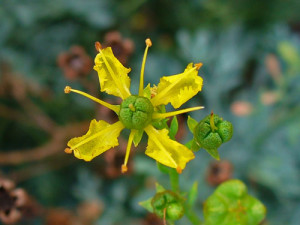Ruta graveolens — commonly known as rue, common rue or herb-of-grace — is a species of Ruta grown as an ornamental plant and as an herb. It is native to the Balkan Peninsula. It is now grown throughout the world in gardens, especially because of its bluish leaves, and also sometimes for its tolerance of hot and dry soil conditions. It is also cultivated as a medicinal herb, as a condiment, and to a lesser extent as an insect repellent
Contents
Uses
-
- It was used extensively in ancient Near Eastern and Roman cuisine (according to Ibn Sayyar al-Warraq and Apicius).
- Rue leaves and berries are an important part of the cuisine of Ethiopia.
- Rue is used as a traditional flavouring in Greece and other Mediterranean countries.
- In Istria (a region in Croatia), and in Northern Italy, it is used to give a special flavour to grappa/raki and most of the time a little branch of the plant can be found in the bottle. This is called grappa alla ruta.
- Seeds can be used for porridge.
- The bitter leaf can be added to eggs, cheese, fish, or mixed with damson plums and wine to produce a meat sauce.
- In Italy in Friuli Venezia-Giulia, the young branches of the plant are dipped in a batter, deep-fried in oil, and consumed with salt or sugar. They are also used on their own to aromatise a specific type of omelette
- Ruta graveolens has several pharmacological effects. According to the “Physicians’ Desk Reference for Herbal Medicines,” the herb is antimicrobial, antispasmodic, photosensitizing and an abortifactant. John M. Riddle, author of “Contraception and Abortion from the Ancient World to the Renaissance,” mentions that rue contains an alkaloid called pilocarpine, which is used in veterinary medicine to induce abortion in horses. According to a paper published in the March 1995 issue of The Italian Journal of Neurological Sciences, it’s also the standard agent given to lab mice to induce epilepsy for the purpose of study and experimentation. On other hand, this alkaloid has a long history of successful use in treating glaucoma and is marketed under several trade names, such as Pilopine HS, Isopto and Diocarpine. Pilocarpine is also an antidote to atropine poisoning. – See more at: http://www.livestrong.com/article/148689-uses-for-ruta-graveolens/#sthash.KnMPhOpk.dpuf
Benefits
Historically, Rue has been used to relieve the pain associated with the physical symptoms of complaints such as gout, rheumatism, and sciatica. Along with alleviating the uncomfortable effects of gas and colic, rue was thought to expel worms from the body. Throughout the years of its use, rue has been used to promote menstruation. It is also used as a digestive tonic and to stimulate the appetite. The herb is edible and often used in salads. It is a good source of flavonoids.
Cautions
- Ruta graveolens should not be used during pregnancy due to the risk of miscarriage. In addition, the presence of furocoumarine increases photosensitivity, even following skin contact with the leaves. – See more at: http://www.livestrong.com/article/148689-uses-for-ruta-graveolens/#sthash.KnMPhOpk.dpuf
Interactions
- None are recorded.
Other names
Rue, common rue or herb-of-grace
References
Source: Wikipedia, https://en.wikipedia.org/wiki/Ruta_graveolens
LiveStrong, http://www.livestrong.com/article/148689-uses-for-ruta-graveolens/
Herbwisdom, http://www.herbwisdom.com/herb-ruta-rua.html

